HR executives have a lot on their plates. They need to be able to do everything from recruitment and onboarding to managing leave requests and employee engagement. To be successful, they need to have the right skills and knowledge.
That’s where an HR LMS proves handy.
HR LMS can provide these professionals with the role-based training they need to be successful in their roles. It can also help them stay up-to-date on HR best practices and the knowledge required to excel at their jobs.
I’ve spent days researching tools in this category and have compiled a list of the 10 best HR LMSs for 2024. In this article, I’ll examine each platform in detail, discussing its strengths and weaknesses. I’ll also provide tips for choosing the right HR LMS for your organization.
| HR LMS | Best For | Pricing |
|---|---|---|
| ProProfs Training Maker | Employee Training | Forever free for small teams. Paid plan starts at$1.99/learner/monthfor large teams. |
| Moodle | Open-Source LMS | Custom pricing |
| Absorb LMS | Complex Training Needs | Custom pricing |
| Docebo | Complex Enterprise Training | Custom pricing |
| iSpring Learn | PowerPoint Conversion | Starts at $2.29/user/month |
| 360Learning | Collaborative Learning | Starts at $8/registered user/month |
| Litmos | External Training | Custom pricing |
| LearnUpon | Training Delivery | Custom pricing |
| SkyPrep | Multi-Tenant LMS | Custom pricing |
| Lessonly by Seismic | Training Sales Teams | Custom pricing |
For a more extensive list of tools, read the whole guide.
What Is an HR LMS?
An HR LMS, or human resources learning management system, is a specialized software platform designed to help users create, manage, share, track, and analyze online training courses and tests for HR teams. It is a centralized hub for organizing and administering training courses, assessments, and other learning materials.
What Are the Features of an HR LMS System?
Being in the training industry, I have seen HR face numerous challenges in managing employee development and other crucial HR tasks.
The introduction of LMS systems has transformed how organizations handle various HR functions. Let me share some very unique features of these systems:
- Easy Course Creation
The best thing about an HR LMS is that you can create various HR courses. From onboarding and compliance training to performance management and professional development, these systems offer intuitive tools that simplify course creation.
Some LMS allow you to add multimedia to your courses, such as images, videos, quizzes, polls, etc. - Customized Learning Paths
HR LMS systems allow HR professionals to create personalized employee learning journeys. This ensures each learner receives development opportunities that align with their career goals and job requirements. - Advanced Analytics and Reporting
These systems provide in-depth analytics and reporting tools. HR can track employee progress, measure the effectiveness of various HR initiatives, and make data-driven decisions to enhance overall HR strategies and outcomes. - Integrated Performance Management
HR LMS systems often include integrated performance management modules. These allow HR to align training programs with performance reviews, career development plans, and employee performance management. - Gamification and Engagement Tools
Many LMSs incorporate gamification elements like badges, leaderboards, and rewards to motivate learners. This not only boosts engagement but also encourages healthy competition among employees. - Mobile Learning Capabilities
Mobile learning is crucial in today’s fast-paced world. HR LMS systems offer robust mobile learning platforms, enabling employees to access training materials anytime, anywhere, and on any device. - Social Learning Features
These systems support social learning by providing forums, discussion boards, and collaboration tools. This fosters a learning community where employees can share knowledge and learn from each other. - Compliance and Certification Tracking
HR LMS systems ensure that organizations comply with industry regulations. They offer tools for tracking certifications, managing compliance training, and generating audit-ready reports, simplifying the compliance management process.
AI-Powered Learning Recommendations
Leveraging AI, these systems can suggest relevant courses and learning materials based on the past performance of employees and learning history. This personalization enhances the learning experience and effectiveness. - Seamless Integration with HR Tools
HR LMS systems integrate seamlessly with other HR tools, such as payroll, performance management, and recruitment systems. This provides a unified view of employee data and streamlines HR processes. - Microlearning and Bite-Sized Content
HR LMS systems offer microlearning modules to cater to the modern learner’s preference for short, focused learning sessions. These bite-sized content pieces make learning more manageable and effective.
By leveraging these unique capabilities, HRs can create a more engaging, effective, and personalized journey for their employees.
Why Do HR Departments Need an LMS?
HRs have more functions to perform than you think!
Today, I’ll explain the many reasons why HR departments need an LMS and how each feature of an LMS caters to these needs:
| Reason for Using an LMS | Aspects of LMS that Help Achieve This |
|---|---|
| Employee Training | Centralized platform, course creation, consistent content delivery, access to resources |
| Compliance Management | Tracking and reporting tools, automated reminders, compliance-specific training modules |
| Performance Tracking | Progress tracking, performance metrics, customizable assessments |
| Cost-Effective | Digital content delivery, reduction in physical materials and travel expenses |
| Scalability | Easily scalable infrastructure, support for large user bases, cloud-based solutions |
| Accessibility | 24/7 access, mobile-friendly interfaces, remote access capabilities |
| Customization | Customizable training programs, role-specific content, adaptable learning paths |
| Data Analytics | Detailed analytics and reporting features, insights into training effectiveness, data-driven decision-making |
| Employee Engagement | Interactive content, gamification elements, multimedia support |
| Onboarding | Structured onboarding programs, access to necessary training and resources, progress tracking for new hires |
Benefits of Using an HR Learning Management System
An HR learning management system brings a lot of benefits, as explained below:
- Enables easy course creation on a range of HR topics like compliance, onboarding, etc.
- All training materials and resources are located in one accessible location
- Tasks such as enrollment, reminders, and tracking are automated, which reduces administrative workload
- Allows for rapid rollout of training programs
- Provides analytics on employee progress, course completion rates, and performance,
- Tracks mandatory training completion to ensure compliance with regulatory requirements
- Minimizes expenses associated with traditional training methods, such as travel, printed materials, and instructor fees
- Offers scalable solutions that grow with the organization
- Customizes learning paths to suit individual employee needs and career development goals.
- Empower employees to complete training at their own pace
- Engages employees with interactive content, such as videos, quizzes, and gamification,
- Encourages feedback from employees
- Simplifies access for employees by enabling single sign-on capabilities
- Maintains detailed records of training activities, aiding in audits and compliance checks
Get Free LMS Software — All Features, Forever.
We've helped 567 companies train 200,000+ employees. Create courses in under a minute with our AI LMS or use 200+ ready-made courses on compliance, harassment, DEI, onboarding, and more!
How to Choose an LMS for HR Training: Questions to Ask
Selecting an LMS for HR is more than just picking software. It is a strategic decision that impacts learning culture, efficiency, and ROI. Before choosing an LMS, here are a few questions you must ask your provider:
1. Learning Experience Design (LXD) Integration:
- Beyond aesthetics: How well does the LMS support LXD principles? Does it facilitate creating immersive, learner-centric experiences?
- Microlearning and performance support: Can the LMS adapt to short-form content and on-demand learning? Does it offer tools for creating performance aids?
2. AI and Personalization Depth:
- Intelligent recommendations: Does the LMS for HR leverage AI to suggest relevant content based on learner behavior and performance?
- Adaptive learning pathways: Can it dynamically adjust content and pace based on individual learner needs?
3. Gamification Efficacy:
- Meaningful rewards: Does the HR learning management offer gamification elements that genuinely motivate learners and align with learning objectives?
- Social learning integration: How well does it foster collaboration and competition through gamified elements?
4. Accessibility and Inclusivity:
- Compliance with standards: Does the LMS adhere to WCAG guidelines and offer features for learners with disabilities?
- Multicultural support: Can it accommodate diverse learning styles, languages, and cultural contexts?
5. Data Analytics and Insights:
- Predictive analytics: Can the LMS forecast learner performance and identify potential drop-off points?
- Actionable insights: Does it provide clear, actionable recommendations based on data analysis?
6. Vendor Partnership and Support:
- Alignment with learning philosophy: Does the vendor share your vision for learning and development?
- Customization flexibility: How open is the vendor to tailoring the LMS to your specific needs?
7. Future-Proofing:
- Scalability: Can the HR learning management system handle increased user loads and content volume?
- Technology integration: Does it support emerging technologies like VR, AR, and AI?
8. Cost of Ownership:
- Hidden costs: Consider factors like implementation, customization, training, and ongoing maintenance.
- ROI measurement: How can you quantify the LMS’s impact on business outcomes?
9. Security and Privacy:
- Data protection: Does the LMS comply with relevant data privacy regulations (e.g., GDPR, CCPA)?
- Incident response: What measures are in place to protect learner data from breaches?
10. User Experience (UX) for All Stakeholders:
- Learner satisfaction: Is the platform intuitive and engaging for learners of all technical abilities?
- Administrator efficiency: Can content creators and managers easily manage the LMS?
By carefully considering these unique aspects, you can choose an LMS that not only meets your current needs but also positions your organization for future learning success.
10 Best HR LMS Systems for Effective Role-Based Training
1. ProProfs Training Maker – Best for Employee Training
ProProfs Training Maker is more than just a learning management system for HR employee training; it’s a strategic asset. One of its remarkable attributes is the ease with which users can develop role-based online employee training programs.
Creating targeted journeys for HR teams is straightforward. You can customize courses and modules based on individual roles and skills, ensuring a laser-focused approach to skill enhancement.
I appreciate the massive library of premium courses that simplify the course development process. These resources are professionally designed, fully editable, and ready to go. Features such as single sign-on (SSO), roles and permissions, and GDPR compliance keep course content and user data safe. Automation, gamification, quiz-based assessments, and real-time tracking and reporting are other features of this HR LMS.
Benefits:
- Instant Notifications: Receive email notifications for completed or due courses and certificate expiration.
- AI-Powered Reports: Assess participation, course completion, and engagement levels with AI-powered reports.
- Custom LMS Certification: Validate course completion with custom LMS certification.
- Collaborative Q&A Forum: Course participants can collaborate effortlessly in the Q&A forum.
- Extensive Course Library: A vast library of ready-made courses designed by subject-matter experts saves time and effort.
Drawbacks:
- No downloadable or on-premise version
- The dark user interface option is not available
- No dedicated account manager for the free plan, unlike the paid version
Pricing:
Forever FREE plan for small teams. Paid plans start at $1.99/learner/month for large teams. No hidden charges.
2. Moodle – Best for Open-Source LMS
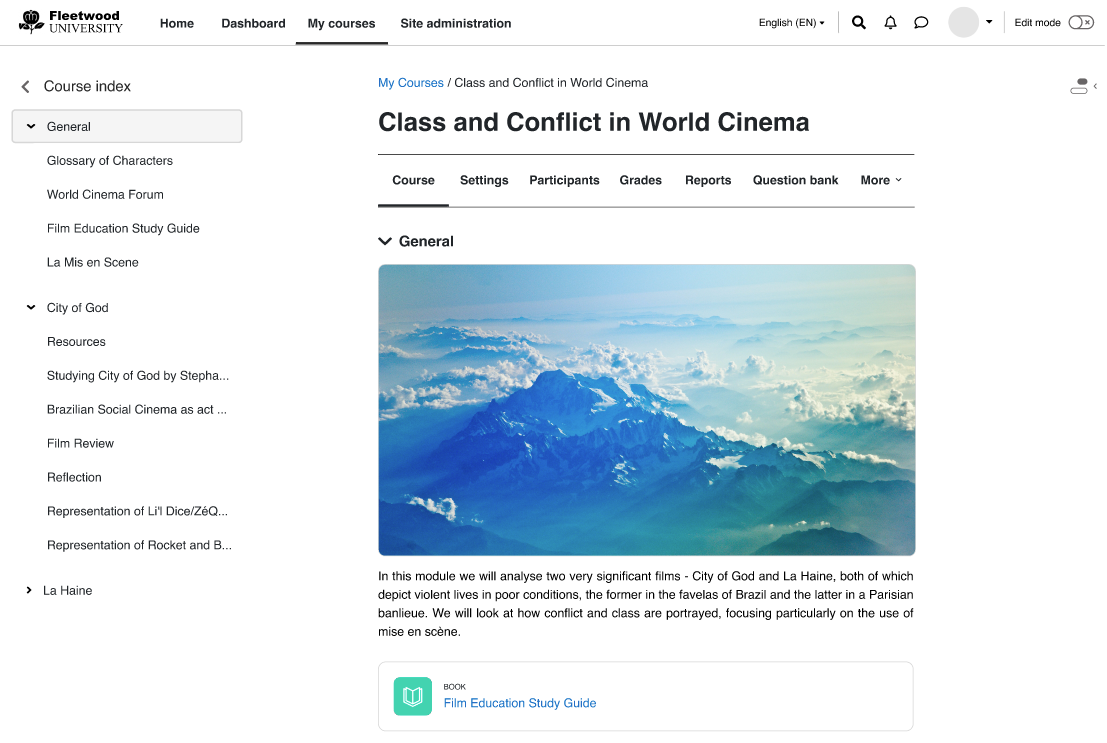
Discover the power of Moodle, an open-source learning platform that transforms the interaction between educators, administrators, and learners.
With Moodle, you can create personalized learning environments tailored to your needs. The best part? It’s completely free to download and customize!
Imagine being able to craft unique learning journeys, participate in collaborative educational experiences, and modify the software to fit your exact requirements. Moodle’s open-source nature means its design is publicly accessible, allowing for endless possibilities.
Benefits:
- Longevity & Sustainability: Enjoy peace of mind knowing Moodle will always be available for use and development, no matter what changes occur in the company.
- Reliability & Security: Benefit from a platform that is continuously updated by a dedicated community.
- Flexibility & Customizability: Tailor Moodle to fit your educational needs, whether in higher education, vocational training, or workplace learning.
- Community Support & Innovation: Join a vibrant community of educators, developers, and learners contributing to the platform.
- Development Expertise: Leverage the expertise of global teams focused on enhancing Moodle, providing you with a robust and user-friendly learning management system.
Drawbacks:
- Transferring content from one semester to another can be a bit of a hassle.
- Building exercises with Coderunner can be tricky and not very intuitive.
- Finding specific settings can sometimes be a challenge due to limited online documentation.
Pricing:
Custom pricing
3. Absorb LMS – Best for Complex Training Needs
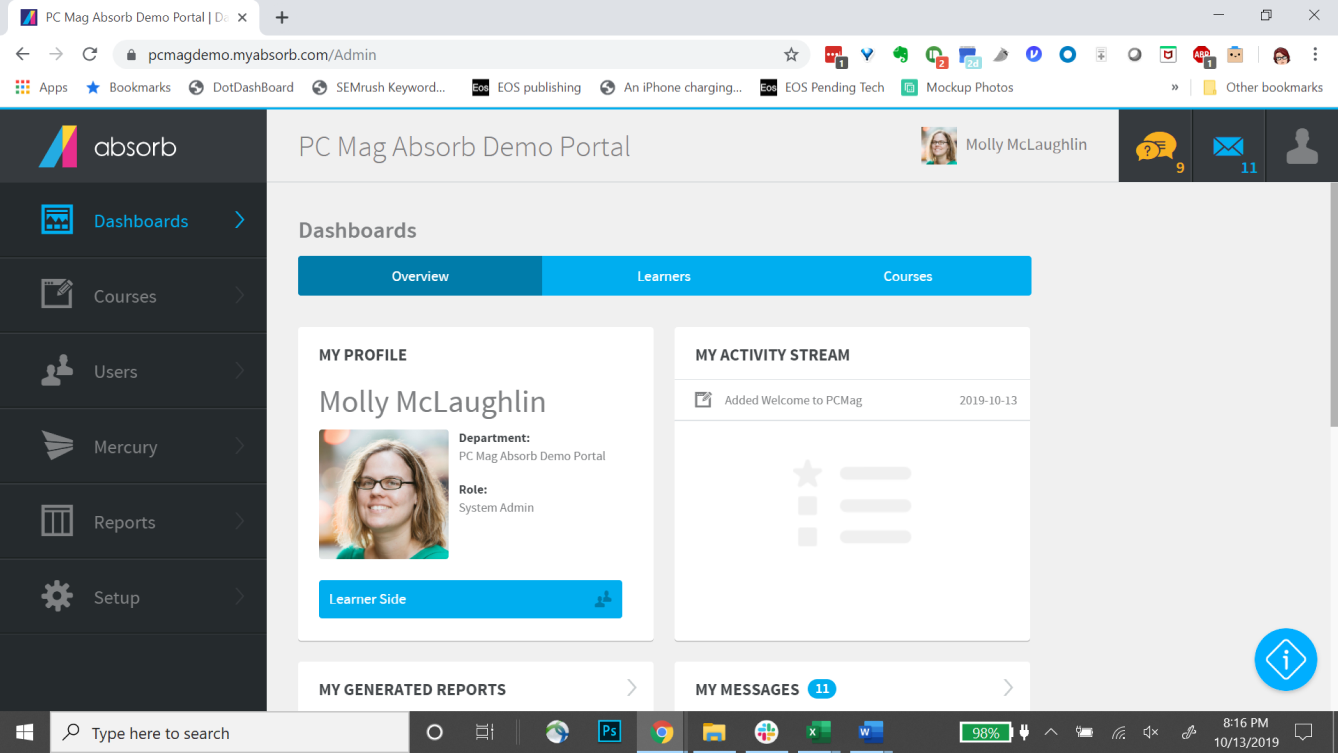
Having tried Absorb LMS firsthand, I can confidently say it’s the best tool for handling complex training needs. Absorb LMS delivers impactful eLearning experiences tailored to your organization’s unique requirements. Its features, like AI-personalized learning paths and seamless integration with workplace tools, make it a standout choice for any comprehensive training program.
Absorb LMS excels in managing the complexities of compliance training, extended enterprise LMS, and employee development with ease.
The platform’s smart administration capabilities ensure efficient user data management and learning activities, while its robust reporting and analytics provide deep insights into learner performance and course effectiveness.
Benefits:
- Collaborative Learning: Engage learners with discussion forums and peer-to-peer interactions, fostering a collaborative learning environment.
- Mobile Learning: The mobile app supports remote learning, allowing learners to access courses anytime, anywhere.
- Enhanced Engagement: Gamification, badges, social learning, and certificates make the learning experience more enjoyable and motivating.
- Administrative Efficiency: Separate portals for learners and administrators streamline the management process, ensuring smooth operations.
- Pre-built Courses: Access a wide range of pre-built courses, saving time and effort in course development.
Drawbacks:
- Initial Setup: The initial setup can be challenging and time-consuming, requiring a significant investment of time and resources.
- Limited Assessment Options: The platform offers limited assessment options when it comes to answer types, which can be restrictive.
Pricing:
Custom pricing
4. Docebo – Best for Complex Enterprise Training
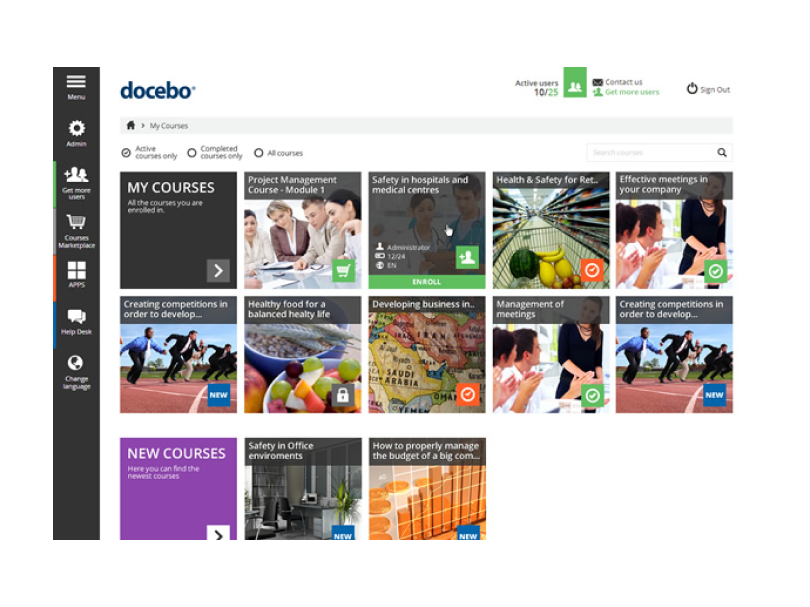
Docebo is a top-notch LMS for external training. Docebo simplifies the retention and expansion of customers, partners, and members by offering tailored training programs that drive product adoption, reduce churn, and ultimately boost revenue.
Docebo covers all stages of the customer lifecycle with continuous customer enablement, ensuring clients renew and grow with your business.
It builds stronger partner relationships by aligning them with your product and vision, and it maximizes member value by sparking engagement with beautiful learner experiences that keep them coming back.
Benefits:
- Collaborative Learning: Discussion forums and peer-to-peer learning create a collaborative experience.
- Mobile Learning: The mobile app supports remote learning so learners can access courses anytime, anywhere.
- Enhanced Engagement: Gamification, badges, social learning, and certificates make the learning experience more enjoyable and motivating.
- Administrative Efficiency: Separate portals for learners and administrators streamline the management process.
- Pre-built Courses: Access a wide range of pre-built courses, saving time and effort in course development.
Drawbacks:
- Search Functionality: The search functionality can be challenging, making it difficult to find specific content quickly.
- Video Publishing Limits: There are restrictions on publishing training videos over a certain size limit, which can be a hindrance.
Pricing:
Custom pricing
5. iSpring Learn – Best for PowerPoint Conversion
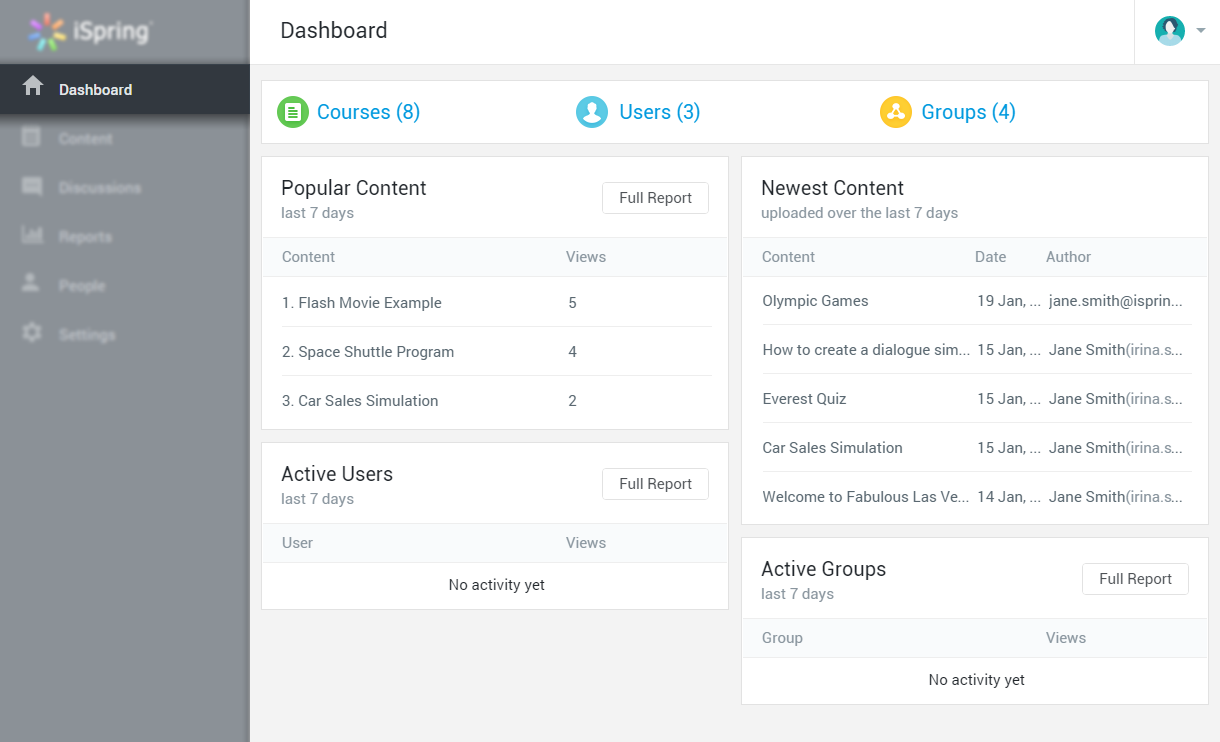
If you want to create interactive and mobile-friendly eLearning content effortlessly, iSpring Suite is the perfect tool for you. iSpring Learn integrates easily with PowerPoint, making it incredibly user-friendly and fast.
Whether you’re developing online courses, video lessons, assessments, or role-plays, the tool has everything you need to create engaging and professional eLearning content.
With features like AI Assistants, Character Builder, and a comprehensive Content Library, iSpring Suite enables you to design courses that are both visually appealing and educationally effective. The platform supports various interactions, quizzes, and video lessons, and it ensures a captivating learning experience that drives better outcomes.
Benefits:
- Ease of Use: iSpring Learn allows you to create courses quickly without needing extensive eLearning development experience.
- AI Assistance: The AI Assistant helps streamline course creation, making writing, editing, and formatting faster and more efficient.
- Customizable Characters: The Character Builder lets you create unique and diverse characters that enhance the relatability and engagement of your courses.
- Comprehensive Content Library: Access over 2,800 ready-to-use icons, 2,500 locations, and 116,000 character images to make your courses more dynamic and interactive.
- Robust Video and Audio Editing: Record and synchronize narrations, add annotations, and edit video and audio content within the suite.
Drawbacks:
- PowerPoint Dependency: The focus on PowerPoint for building decks can be a limitation, especially for Mac users.
- Completion Score Issues: Hidden deck slides can result in inaccurate completion scores, preventing users from completing the training.
Pricing:
Starts at $2.29/user/month
6. 360Learning – Best for Collaborative Learning
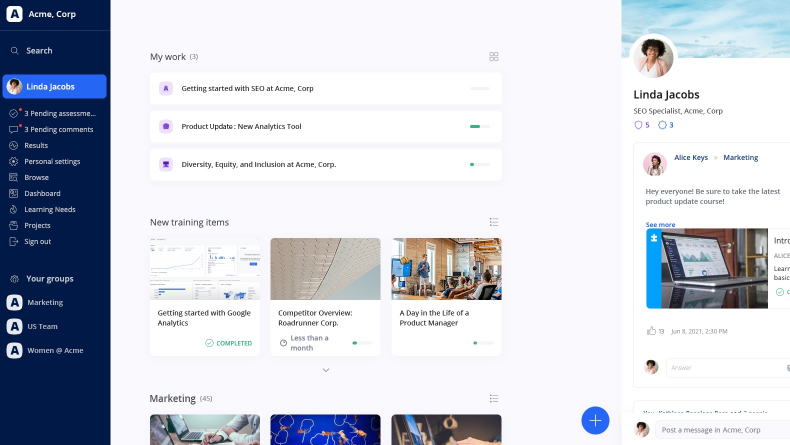
Collaboration is an essential part of training, and 360Learning makes it a breeze to build a culture of collaborative learning. This platform allows you to upskill from within and stay ahead in the battle for skills.
I’ve found that 360Learning transforms learners into teachers and teachers into learners, creating a dynamic and interactive environment.
With features that enhance collaborative learning, you can capture and share knowledge across your organization, ensuring your team is always growing and improving. Plus, it’s like having your own personal learning superhero on call.
Benefits:
- High Engagement Rates: With an average completion rate of 91%, 360Learning courses are the rock stars of the eLearning world.
- Collaborative Learning: Empower learners and experts to work together. It’s like a knowledge-sharing party where everyone’s invited!
- Comprehensive Support: Enjoy industry-leading support and training, including access to the 360Learning Knowledge Base.
- Scalable Course Development: Streamline training delivery and maintain visibility with end-to-end project management.
- Real-Time Feedback: Optimize course content with in-course commenting, threaded Q&As, and learner relevance scoring.
Drawbacks:
- Technical Issues: Occasionally, a technical hiccup may pop up, but hey, even the best heroes have their off days.
- Multiple-Choice Layout: MCQs could be more efficiently placed on a single page to enhance user navigation, like a choose-your-own-adventure book, without flipping back and forth.
Pricing:
Starts at $8/registered user/month
7. Litmos – Best for External Training
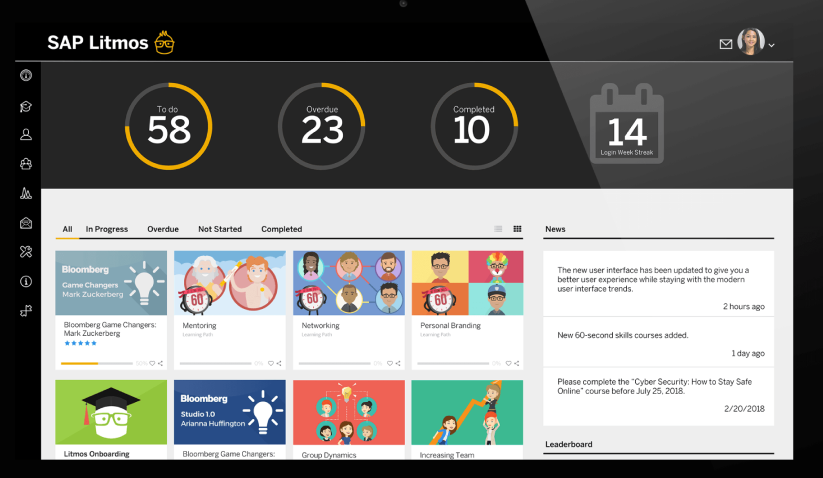
Here’s another tool I’d recommend, especially if you want to leverage training for increased revenue potential: the Litmos. It is designed to train customers, partners, and others outside your employee base. It includes a flexible LMS, public catalog, eCommerce tools, and limitless branding options, all aimed at facilitating smooth training business operations.
With Litmos, you can scale globally, accommodating large user bases across various regions and time zones. The platform offers multi-lingual support and a flexible infrastructure to adapt to fluctuating demand. It also allows businesses to optimize revenue opportunities by offering a public catalog of training courses or certifications to external users.
Litmos integrates with eCommerce applications like Shopify and CRM platforms like Salesforce’s Digital Experience Cloud. This comprehensive solution supports robust eLearning, virtual instructor-led training (vILT), and advanced e-commerce features, making it an essential tool for any organization.
Benefits:
- Efficient User Management: Automate user onboarding, course assignments, and team placements to save time and effort.
- Comprehensive Support: Benefit from Litmos’s extensive support services, ensuring smooth operation and troubleshooting.
- Scalable Infrastructure: Adapt to fluctuating demand with Litmos’s flexible infrastructure.
- Detailed Analytics: Utilize advanced reporting and analytics to gain insights into training effectiveness and user engagement.
- User-Friendly Interface: Despite the initial learning curve, the platform’s interface is designed for ease of use once mastered.
Drawbacks:
- Greater flexibility with tools, such as drag-and-drop functionality for videos when building content, would be beneficial.
- User filter and search options similar to Excel, without the need to export data, would enhance usability.
Pricing:
Custom pricing
8. LearnUpon – Best for Training Delivery
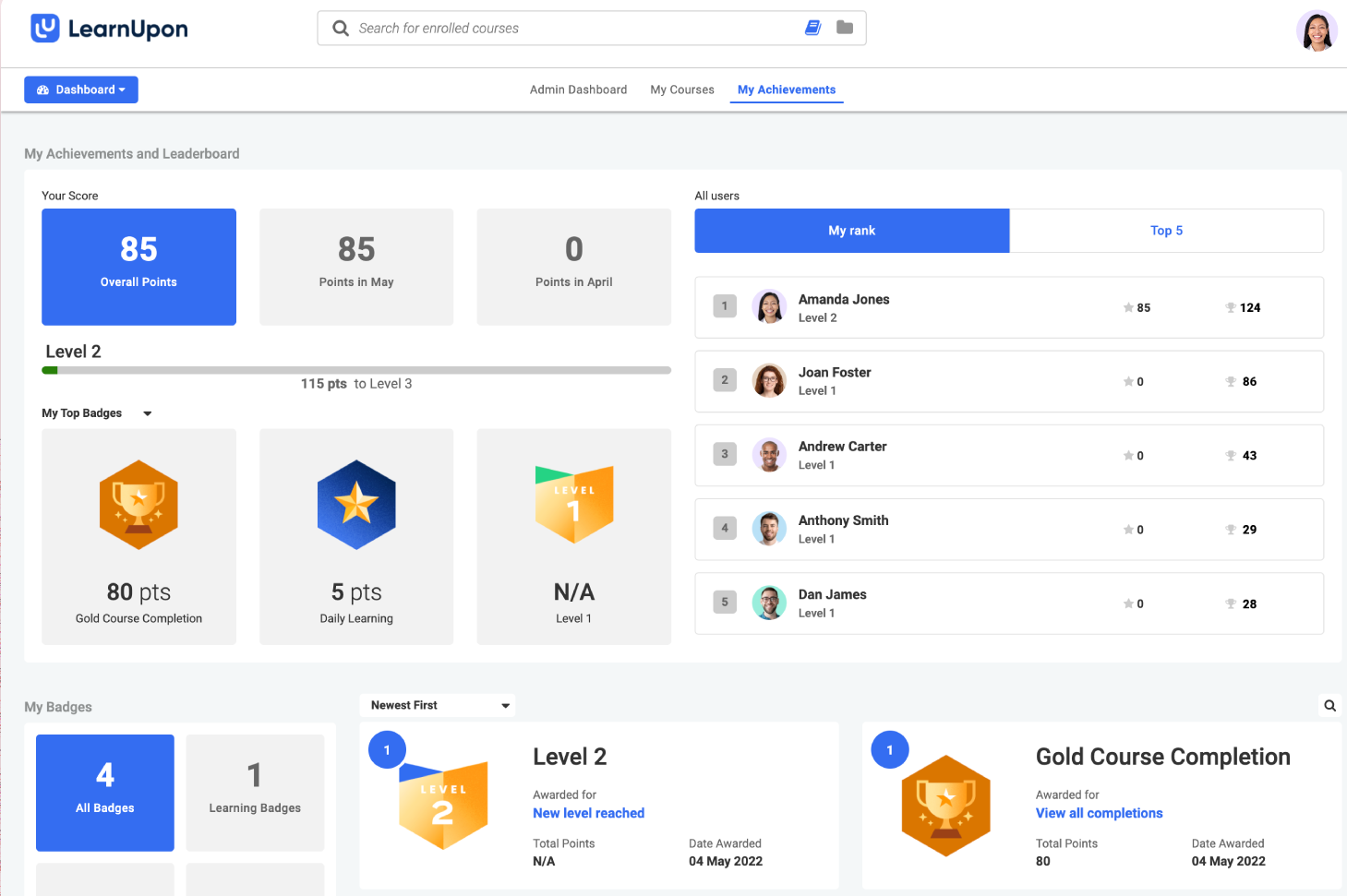
Designed to deliver impactful training, LearnUpon allows you to create both formal and informal learning experiences that align with your organization’s training needs. With built-in assessment functionality, learners can manage their training efficiently.
LearnUpon offers a powerful toolkit to create engaging and effective learning experiences. Mix things up with exams featuring multiple question types, or challenge learners with assignments that demand direct input or file uploads. Keep the momentum going with knowledge checks strategically placed throughout your courses.
Want to create a truly learner-centric experience? LearnUpon’s feedback loops, surveys, and reviews let you gather valuable insights to refine your programs. With Learning Paths, you can build well-structured learning journeys, customizing the sequence or allowing learners to choose their own path.
Benefits:
- Streamlined Enrollment: Automated workflows and robust integrations make it easy to enroll thousands of learners quickly and efficiently through a centralized system.
- Autonomous Learning: Learners have access to their training activities and history and can self-enroll in courses.
- Detailed Analytics: Gain insights into learner progress and training effectiveness with comprehensive dashboards and reporting features.
- Flexible Learning Options: Offer a mix of mandatory and self-serve learning opportunities tailored to individual or group needs.
- Resource Center: Create a resource hub with reference documents that learners can view and download anytime.
Drawbacks:
- Lack of Visual Indicators: When a learner is disabled, there is no visual indicator until you click into their profile, adding extra steps to the process.
- Search Reporting: There is no report to track keyword searches and their results, which could help optimize content discoverability.
Pricing:
Custom pricing
9. SkyPrep – Best for Multi-Tenant LMS
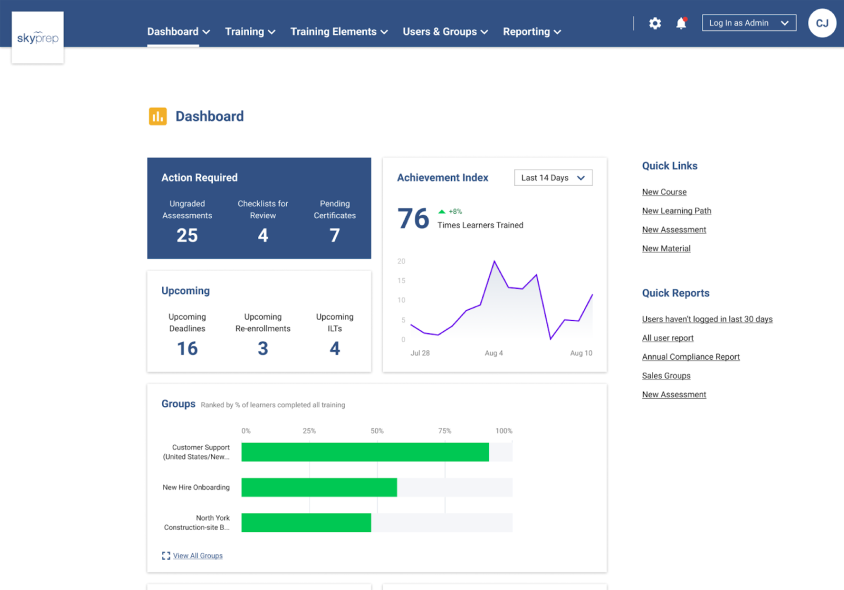
If you’re looking to scale your training as your audience grows, SkyPrep is your go-to solution. This platform allows you to create separate portals for each of your different brands and clients, all under one account.
Whether you need to train employees, customers, or partners, SkyPrep makes it easy to manage multiple platforms, share content, and customize the learning experience to suit your unique needs. The white-labeled platforms allow you to give each audience a tailored experience with distinct branding and content, all while maintaining a cohesive training strategy across your organization.
SkyPrep’s robust LMS features include the ability to create sub-platforms for different segments of learners and easily navigate and manage them all under one umbrella. This feature is particularly useful for organizations with diverse training needs.
Benefits:
- Efficient Content Sharing: Share courses across multiple platforms to ensure consistent and high-quality training.
- Extensive Customization: Each learning portal can be customized with unique colors, logos, login pages, and more to align with each brand’s identity.
- Award-Winning Ease of Use: Recognized for its user-friendly interface and makes management straightforward and effective.
- Scalable Infrastructure: Adapt to growing training needs with SkyPrep’s flexible and scalable infrastructure.
- Streamlined Management: Easily create and manage multiple sub-platforms under one account.
Drawbacks:
- User Feedback Email: The user feedback email is currently unavailable in the most updated version of SkyPrep, which can limit direct user feedback.
- Manager Search Field: Adding a search field for selecting a manager for a group would enhance usability and save time.
Pricing:
Custom pricing
10. Lessonly by Seismic – Best for Training Sales Team
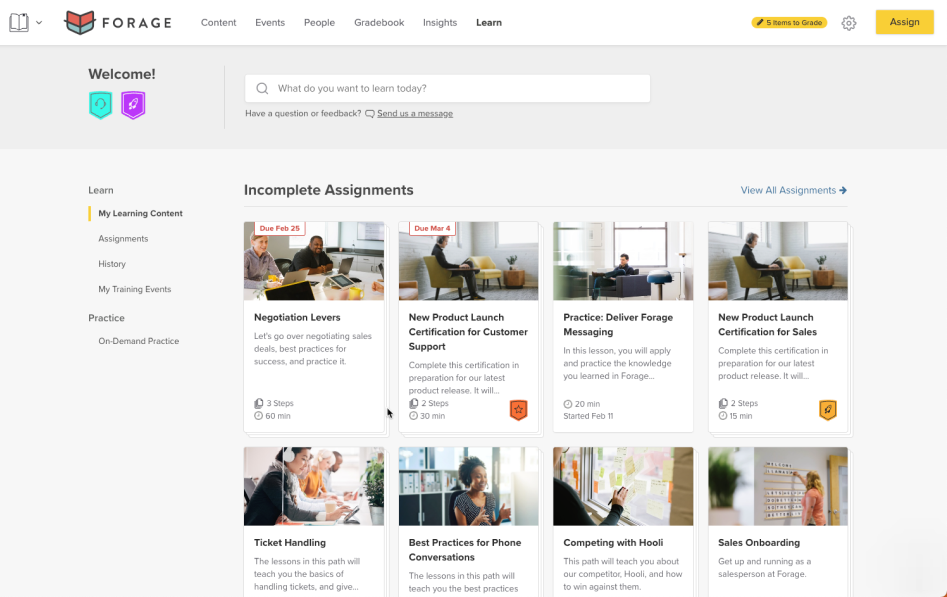
The last tool I’d add to this list is Seismic, a powerhouse platform that ignites revenue growth for customer-facing teams. Seismic’s Enablement Cloud is designed to unify your sales content management, learning, coaching, and buyer engagement strategies under one roof.
With Seismic, you can create an impactful experience for your sales teams and ensure they have the right resources when needed. The platform also offers advanced content automation, keeping your sales collateral current and relevant.
The learning and coaching modules help increase new reps’ speed-to-competency by providing consistent, trackable training programs. One of the standout features of Seismic is its ability to streamline sales operations and boost efficiency.
Benefits:
- Enhanced Sales Efficiency: Close deals faster with personalized, easily accessible content and real-time answers.
- Improved Training Programs: Ramp up new reps 30% faster with consistent, trackable training and coaching modules.
- Centralized Strategy and Planning: Centralize your enablement efforts with a platform that combines strategy, planning, execution, and insights.
- Advanced Analytics: Use robust analytics and reporting tools to gain insights into content effectiveness and training impact.
- Seamless Integrations: Integrate with platforms like Salesforce and Microsoft to extend functionality and streamline operations.
Drawback:
- Video Hosting: While embedding videos is easy, Seismic doesn’t allow for video hosting, which might be a limitation for some users.
- Grading Key for Assessments: Without a grading key, administrators may find it challenging to grade written answers.
Pricing:
Custom pricing
Which Is the Best LMS for HR Training?
Choosing the ideal LMS requires you to consider the specific needs. To assist you in this journey, I’ve narrowed the selection to three compelling options.
Option A: ProProfs Training Maker
ProProfs Training Maker can be an excellent choice for HR training due to its user-friendly interface, ready-to-use courses, in-course quizzes, surveys, and AI-driven reports. In addition, it provides automated certification and engaging gamification elements. The LMS boasts a fully responsive design, ensuring easy access and navigation anytime, anywhere, and on any device.
Option B: Docebo
Docebo’s platform excels in course creation, offering intuitive tools for engaging training content. Its AI-driven recommendation engine personalizes learning paths, while the analytics dashboard provides insights for effective training strategies. Gamification and certification tracking enhance the learning experience and ensure compliance.
Option C: 360Learning
360Learning is an exceptional option for HR training, particularly for its collaborative approach. It fosters a culture of shared knowledge with social learning features, allowing HR professionals to learn from each other. The LMS enables interactive content creation and engagement, creating an immersive learning environment.
Pick the Right HR LMS for Your HR Team!
Navigating the sea of HR LMS options can feel overwhelming, but making the right choice is critical for the success of your HR initiatives.
In my experience, the stakes are high when selecting an HR LMS, and a misstep can lead to wasted resources and missed opportunities for growth. Trust me; I’ve been there, done that, and regretted it. Don’t make the same mistake!
The key is to align your choice with your organization’s specific needs. Remember, the right HR LMS should streamline your HR processes, engage your employees, and provide actionable insights to improve your HR functions continuously. Evaluate your options based on features, benefits, and pricing, and don’t hesitate to ask your vendors essential questions.
After all, the goal is to enhance employee development, compliance, performance management, and overall HR efficiency across your organization effectively.
 Tips
Tips
We’d love to hear your tips & suggestions on this article!
Get Free LMS Software — All Features, Forever.
We've helped 567 companies train 200,000+ employees. Create courses in under a minute with our AI LMS or use 200+ ready-made courses on compliance, harassment, DEI, onboarding, and more!

 We'd love your feedback!
We'd love your feedback! Thanks for your feedback!
Thanks for your feedback!





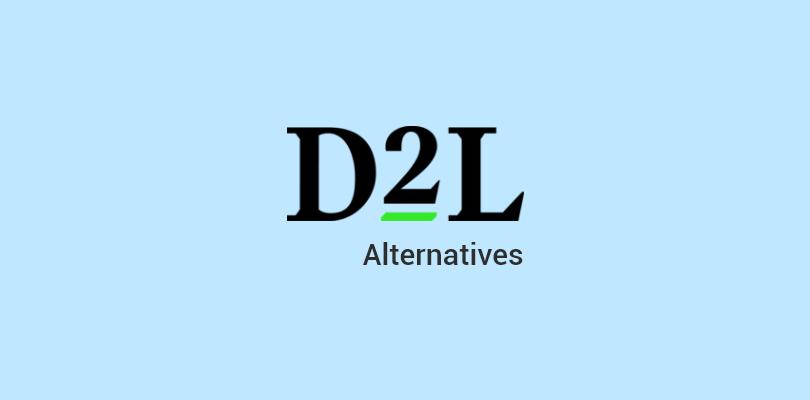

![12 Best Enterprise Learning Management Systems in 2025 [Free & Paid Platforms]](https://www.proprofstraining.com/blog/wp-content/uploads/2024/08/Feature_TM_Enterprise-Learning-Management-Systems_-Features-Benefits-and-Best-Tools.png)